Cool Jobs: Probing Pluto
These scientists and engineers worked together to take New Horizons to the dwarf planet
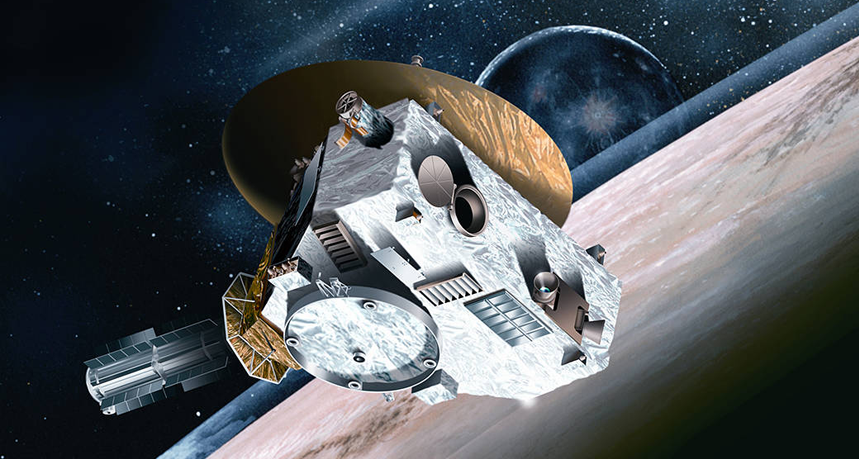
An illustration of what the New Horizons spacecraft would have looked like as it was flying past Pluto.
Johns Hopkins University Applied Physics Laboratory/Southwest Research Institute
By Ron Cowen
July 4, 2015, was supposed to be a routine day at the mission operations center for NASA’s New Horizons spacecraft. After a 9.5-year journey across the solar system, that craft was just 10 days away from flying past Pluto. It would take the first close-up photos of the dwarf planet.
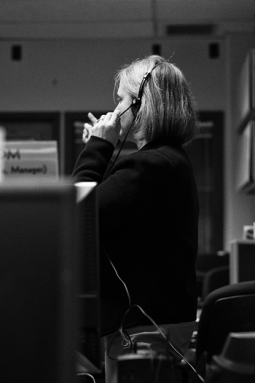
Yet on this U.S. holiday — Independence Day — NASA’s New Horizons crew was suddenly called into work at Johns Hopkins University’s Applied Physics Laboratory in Laurel, Md. A potential crisis had emerged: The spacecraft had fallen silent.
The scientists and engineers met up in the “situation room,” just outside the operations center. Among those in charge was Alice Bowman. She was the project’s “MOM,” or mission operations manager. It would be up to Bowman and her colleagues to find out what made the craft go mute — if they could.
In her off hours, Bowman dives into music. (An accomplished clarinetist and bass fiddle player, she’s partial to bluegrass.) Right now, however, she was all business.
Soft spoken and quietly confident, Bowman is NASA’s first female MOM. She’d had this role since 2002. That’s when she stepped up to shepherd the New Horizons spacecraft through its 4.8-billion-kilometer (3-billion-mile) trek to Pluto. Her team was charged with testing every command before it was radioed to the craft. This made sure that those instructions could be executed safely. It also ensured that every signal transmitted from New Horizons would be recorded back on Earth.
And at 1:55 p.m. East Coast time (ET) on this day, MOM’s baby had stopped broadcasting.
Bowman and her team had no idea if the spacecraft was still alive. They knew there was about a one in 10,000 chance that a piece of space debris had disabled the craft. New Horizons was now moving at 52,300 kilometers per hour (32,500 miles per hour). At that speed, colliding with even something as small as a grain of rice might prove fatal.
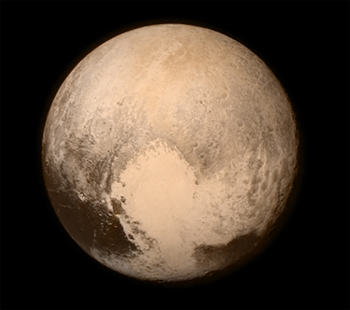
And even if New Horizons was intact, there was no way to be sure that it still would be on July 14. That was when it was due to fly past Pluto. Its one and only shot at exploring the dwarf planet, close up, was a mere 10 days away.
Without a signal from the craft, troubleshooting “is like stabbing in the dark because you don’t have any information at all,” explains Bowman.
Space missions can be full of surprises. So the people charged with pulling off these novel endeavors have to be clever and ready for the unexpected. Here we meet some of those who worked under pressure to ensure that the New Horizons mission achieved its goal — turning Pluto from a distant, fuzzy point of light into a real landscape.
Enlisting some big ears
On that July 4, the team desperately searched for signs the spacecraft was still alive. “You need to let your team work though all the different scenarios and recreate on the ground what’s going on [with the spacecraft],” notes Bowman. “If you don’t fully understand the problem before you start trying to fix it, you can get yourself into deeper trouble.”
One possible explanation for its radio silence was that a glitch that forced New Horizons to switch to its backup computer. In that case, the spacecraft might still be broadcasting, just at a slightly different frequency. To test this idea, MOM and her team quickly contacted NASA’s Deep Space Network.
That network consists of three large radio dishes (near Barstow, Calif.; Madrid, Spain and Canberra, Australia). These ears on the universe are charged with signaling and listening to spacecraft. The network’s new mission: Search for any broadcasts at the new frequency. Only the Canberra dish was at the right location to listen for it.
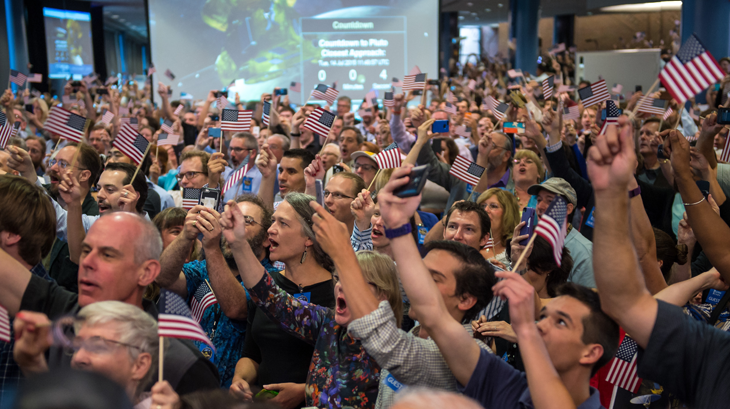
At 3:11 p.m. ET, a signal from the spacecraft arrived at the mission operations center. The Canberra radio dish had found New Horizons. It was still alive!
But that didn’t end the tension. Indeed, the only sleep Bowman would get for the next two days were 15-minute catnaps on her office floor. (It took those days to make sure the craft could take new commands and transmit images.) But at least for now, MOM knew her spacecraft was safe and its mission to Pluto was still on track.
How this MOM got there
Growing up in Richmond, Va., Bowman had caught the space bug early. She had been fascinated by the Gemini rocket program. This NASA project paved the way for the Apollo missions, which ferried people to the moon.
On July 20, 1969, peeking through her fingers at the images on her family’s black-and-white television set, 8-year-old Bowman, her sister and mother watched astronaut Neil Armstrong land on the moon. “It was scary and neat at the same time,” she recalls.
In college, Bowman studied both chemistry and physics. After graduation, she helped develop anticancer drugs. She also developed solid-state sensors to help astronomers and the military detect infrared radiation — heat. But an interest in satellite operations ultimately brought her to Hopkins’ Applied Physics Laboratory as an engineer. Her first job there was as part of a military-sponsored project to map bright sources of infrared radiation in the sky. The program’s goal was to be able to track the path of possible incoming ballistic missiles.
From that project and others, Bowman learned the importance of teamwork. On New Horizons, she notes, “My calmness comes from the trust I have in all my teammates and the expertise, support and respect we share with and give each other.”
Some of her team had advanced degrees in physics or engineering. But Bowman says she never needed more than her four years of college: “Physics and chemistry was the foundation that enabled me to move into spaceflight operations.”
From puzzles to astronomy
Cathy Olkin was deputy project scientist for the New Horizons mission. As a child, she enjoyed math. Yet in third grade and again in middle school, her math teachers had labeled her as a slow learner or hard to teach. In fact, she was neither. Bored with the standard coursework, Olkin was trying to tackle math puzzles on her own instead of focusing on class. Fortunately, her parents had faith in the girl’s abilities. And two teachers would eventually nurture her love of puzzles. In the end, they turned her frustration into success.
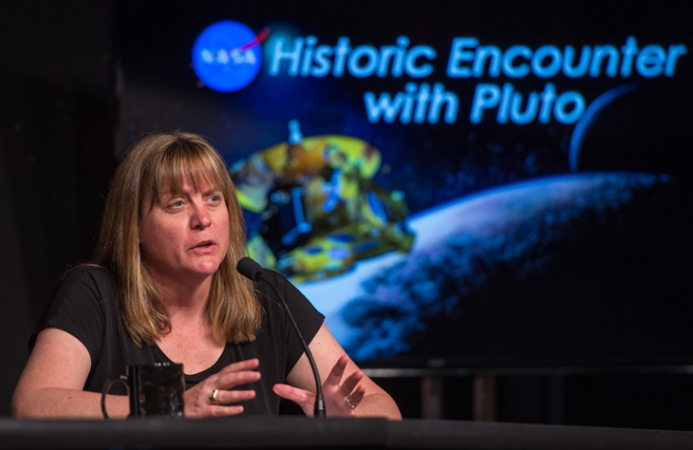
To prove that Olkin could do basic addition and subtraction, her father devised a game for her at the supermarket. If she could figure out how much change her family was due before the supermarket cashier did, she could keep the money. Olkin pocketed cash every time.
As a teen, astronomy was not the only science that intrigued her. Olkin’s interests jumped from rock hound to archaeologist to doctor.
In fact, years before Olkin analyzed the makeup of ice on Pluto, she was collecting rocks on Earth. In fifth grade, she became fascinated with her teacher’s rock tumbler, marveling at how it made the rocks shiny. Soon, she was asking her parents to stop on the side of highways, near construction sites, so she could pick up new rocks.
Around that time, one of her teachers gave Olkin a Petoskey stone. Such rocks are decorated with the hexagonal (six-sided) shape of fossilized coral that are native to her home state of Michigan. She still has that stone.
Although many of Olkin’s interests shifted over time, two always remained: her love of unusual math puzzles and a keen interest in taking things apart. Early on, these interests sometimes risked getting her in trouble. Such as when she dismantled her family’s rotary telephone (these were the days long before touch-tone and cell phones). Her father, a doctor, was on call. He had to have a working phone in case the hospital suddenly called him in on an emergency. (At her mother’s urging, Olkin quickly put the phone back together.)
Although Olkin had intended to follow in dad’s footsteps and become a physician, she chose to attend the Massachusetts Institute of Technology in Cambridge. The university is known for its engineering program. There, “I looked around and saw all these opportunities that I had never fully appreciated,” she says.
“I was more interested in building things than being a doctor,” Olkin says. “So I switched.”
She went on to earn a master’s degree in aerospace engineering from Stanford University in California. After that, Olkin found work on spacecraft navigation at NASA’s Jet Propulsion Laboratory in Pasadena, Calif. Planning a path through space for missions like the Saturn-bound Cassini spacecraft fascinated her.
But not quite enough. She went back to school for a PhD in planetary science. While there, she examined the atmosphere of Triton, Neptune’s largest moon. The thin atmosphere of such a distant moon isn’t normally visible, so Olkin and her colleagues relied on a well-known trick to probe it. They used the light of a background star. As that star’s light filters through, it reveals the chemicals in the atmosphere’s gasses.
Story continues below image
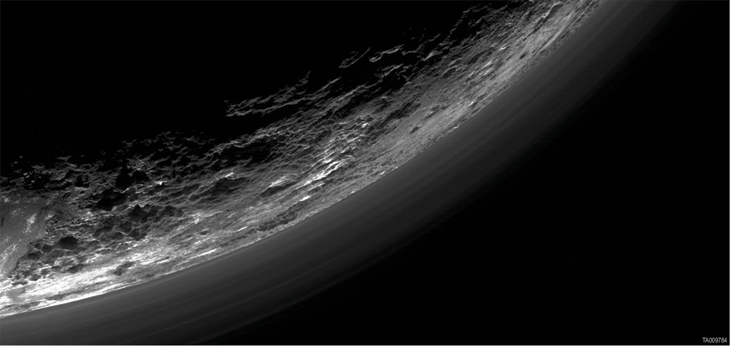
On to Pluto
Olkin tried to study Pluto’s atmosphere the same way. Alas, no background star happened to pass behind the dwarf planet during her studies.
Then, in 2004, after taking a break from research to care for her two young children, she joined the Southwest Research Institute in Boulder, Colo. This research center was designing the New Horizons Pluto probe. Olkin’s diverse experience — in designing instruments, planning orbital navigation and planetary science — paid off. So did her drive to excel.
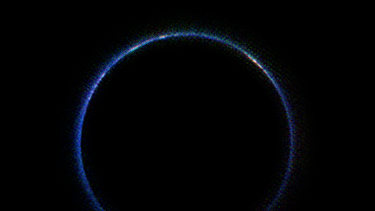
She began working on a New Horizons instrument called Ralph. This telescope makes images of objects in both visible light and longer, infrared wavelengths. Before long, Olkin started taking on more assignments. “When people do good work, people ask them to do more,” she notes. “I never actually imagined that I would be doing all the different things [on the mission] that I am doing now.”
By 2015, Olkin had spent 8 years as part of a three-person team that turned the wish list of scientists working with the spacecraft’s seven instruments into a coordinated plan to spy on Pluto as closely and deeply as possible. They decided which observations to make and in what order so that they could get the most data possible during the brief flyby.
Olkin also helped figure out at what distance the craft should fly past Pluto. Get too close and the images would lack the global view that scientists wanted. Stay too far back and the images would lack detail. Her team even helped choose which side of Pluto to fly past. They chose the “face” that was known to be brightest in carbon-dioxide ice. It seemed easiest to image. Its rocky makeup also seemed likely to be the most interesting.
“It was dumb luck that [that face] had this large, heart-shaped glacier,” says Olkin. However, she notes that her team had always suspected that side of Pluto would prove intriguing.
Hands-on science
Mark Holdridge was manager of the mission’s encounter with Pluto. Like Olkin, he began tinkering at an early age. He grew up in rural Highland, Md. His father, an electrical engineer, had tried to interest the boy in that line of work. But “I needed something more visual,” Holdridge says. He found it next door — in his neighbor’s tool shed. It had been converted from an old barnyard. The boy became a frequent and welcome visitor, learning to use the drill press and other tools to work on his own projects.
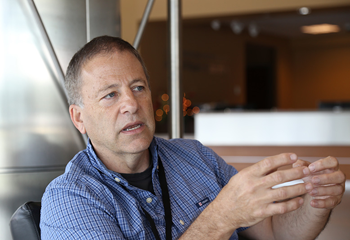
A workbench his father bought him one Christmas — made from a long door and four legs — became his muse for building, woodworking and general tinkering. Working on his own, without supervision, “I was lucky I didn’t burn the house down,” he now says.
In college and graduate school, Holdridge pursued aerospace engineering. Still, he found himself more drawn to the space side of things. And harkening back to those tinkering days, he found he preferred working on things that were “more hands on.” He says, “I think that’s probably why I do flight operations.” Why? These do not involve theory so much as working with concrete objects.
In the late 1990s, Holdridge managed operations for NASA’s first mission to orbit an asteroid. There had been friction between managers and engineers on this mission, known as NEAR. (NEAR stands for Near Earth Asteroid Rendezvous.) But Holdridge ultimately got the groups to trust each other.
There was also drama aboard the spacecraft. Its main thruster failed to fire in late December 1998. That left the craft in danger of never reaching the asteroid it was supposed to orbit (named 433 Eros). A successful firing 11 days later brought the craft back on track. It not only orbited the space rock for an entire Earth year but also landed on it. That was a bonus — something the craft had not even been designed to do.
NEAR’s success jump-started Holdridge’s career. It also paved the way for his work with New Horizons. But there’s a world of difference between managing a visit to a near-Earth asteroid versus an object on the edge of the solar system.
“Deep space is unforgiving,” he notes. Adding to the challenges was the 9-hour-long delay in round-trip communication between Earth and a very distant spacecraft.
“Whenever we were going to do a maneuver, I was always preparing for the worst and hoping for the best,” he recalls. “My fear,” Holdridge says, “was that there was going to be some huge unknown error.”
And then there are the anxieties, he adds. After working on something important for 15 years, he says you realize “you’ve got only one chance to get it right. “
But his team did get it right. After traveling nearly a decade (some 300 million seconds) to the solar system’s fringes, New Horizons arrived at Pluto right on time. Well, almost. New Horizons actually arrived 1 minute, 28 seconds earlier than planned.
Story continues below image
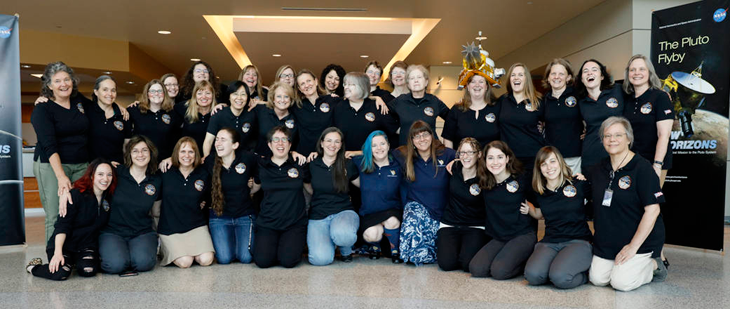
Learning on the job
Holdridge, Bowman and Olkin held many jobs before joining New Horizons. Not Coralie Jackman. One of the youngest members of the team, she joined just out of college, more than five years ago. As an optical navigations specialist, this engineer helped make sure the craft stays on course.
She works at KinetX Aerospace in Simi Valley, Calif. Until a year before the flyby, the spacecraft was too far away from the dwarf planet to image the body in sufficient detail. Pluto scientists needed other ways to monitor their target. So for her first three years on the job, Jackman used computers to model the exact location of the center of the Pluto system (which includes one large moon and four far smaller ones in addition to Pluto).
Friends on other engineering projects would typically see results within months of starting. Jackman would have to wait years. By the spring of 2015, the craft began recording images of the dwarf planet that were sharper than those taken by the Hubble Space Telescope. Nearly every day, an image of Pluto would arrive that was sharper than one from the day before. What had been a faint point of light was turning into a world sculpted by ice.
These pictures proved critical for refining the distance between the craft and Pluto. They helped determine if and when New Horizon’s thrusters would need to be fired to keep the spacecraft on course.
What steered her to this career?
Until she entered high school outside Chicago, Ill., Jackman had wanted to become an archaeologist. But in 2004 she was captivated by an image taken by the upgraded Hubble Space Telescope. Called the Hubble Ultra Deep Field, this photo provided the sharpest and most distant view of galaxies in the universe. They revealed what the cosmos looked like only a few hundred million years after its birth.
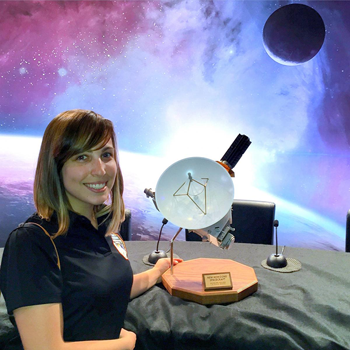
“Just seeing the photograph really got me interested in space,” she says. “I kind of dove right in.”
As a teen, Jackman threw annual star parties. She’d set up telescopes at her school to observe the heavens. “I wanted to share what I loved,” she says. A high school teacher also encouraged her to apply for an internship at Chicago’s Adler Planetarium, the nation’s oldest. And she succeeded. For two summers she tracked comets and asteroids at the Yerkes Observatory, two hours away in Williams Bay, Wisc.
By college, Jackman knew she wanted to work on a space mission. But she also knew she did not want to spend 10 years in school, studying to get a PhD. The teen figured that becoming an engineer was a faster route to joining a space mission. She focused on spacecraft navigation, she recalls, “because it straddles the line between engineering and science.”
When she later applied for a job at KinetX, her prospective boss reviewed all that she’d done since high school. He told the young woman that it looked like she’d been training her whole life to be a navigator. In fact, she says, “I had just followed what I thought was interesting.” Now, while continuing to work at KinetX, she’s earning a master’s degree in aerospace engineering.
NOTE: Story corrected for an initial error in the reported speed of New Horizons when it went quiet.
This is one in a series on careers in science, technology, engineering and mathematics made possible with generous support from Arconic Foundation.







